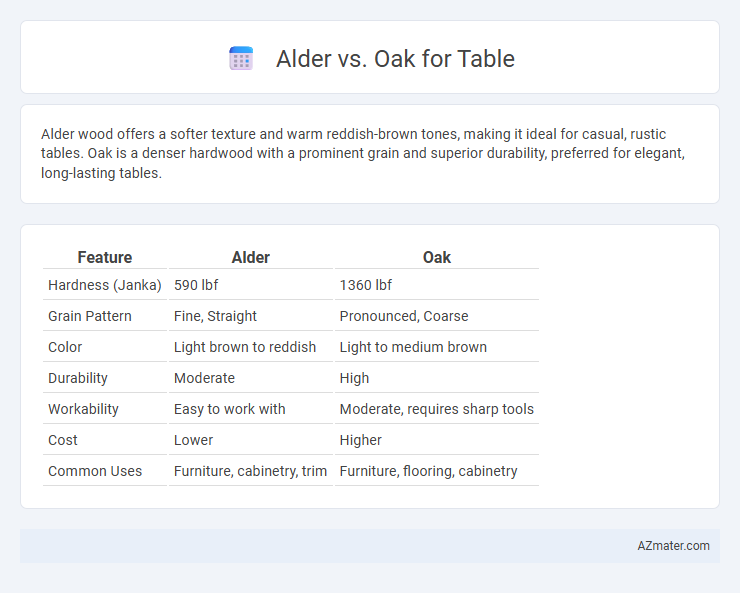Alder wood offers a softer texture and warm reddish-brown tones, making it ideal for casual, rustic tables. Oak is a denser hardwood with a prominent grain and superior durability, preferred for elegant, long-lasting tables.
Table of Comparison
| Feature | Alder | Oak |
|---|---|---|
| Hardness (Janka) | 590 lbf | 1360 lbf |
| Grain Pattern | Fine, Straight | Pronounced, Coarse |
| Color | Light brown to reddish | Light to medium brown |
| Durability | Moderate | High |
| Workability | Easy to work with | Moderate, requires sharp tools |
| Cost | Lower | Higher |
| Common Uses | Furniture, cabinetry, trim | Furniture, flooring, cabinetry |
Introduction: Alder vs Oak for Table-making
Alder and oak are popular hardwoods frequently chosen for table-making due to their distinct qualities and appearance. Alder offers a softer texture with a fine, even grain, making it easy to work with and ideal for smooth finishes. Oak, known for its exceptional hardness and pronounced grain patterns, provides superior durability and a classic, rustic aesthetic favored in long-lasting furniture.
Wood Characteristics: Alder and Oak Compared
Alder wood is lightweight, soft, and smooth with a fine, straight grain, making it easy to work with and ideal for crafting tables with intricate details or a uniform finish. Oak is denser, harder, and more durable, featuring prominent grain patterns and a coarse texture, offering superior resistance to wear and moisture for long-lasting table surfaces. Choosing between alder and oak depends on desired durability versus ease of shaping, with oak favored for heavy-use tables and alder preferred for refined aesthetics.
Durability and Strength: Which Lasts Longer?
Oak tables offer superior durability and strength compared to alder, making them ideal for long-term use and heavy daily wear. The dense grain structure of oak resists dents and scratches better, ensuring a longer lifespan. While alder is softer and easier to work with, it may show signs of wear sooner under constant use.
Appearance: Grain Patterns and Color Differences
Alder wood features a fine, straight grain with occasional knots, presenting a smooth and uniform texture ideal for rustic or casual table designs. Oak displays a prominent, coarse grain with distinctive rays and flecks, offering a bold and textured look suitable for traditional or statement pieces. In terms of color, alder tends to have warm, reddish-brown hues that darken over time, while oak typically ranges from light tan to medium brown with a slightly yellow undertone, providing diverse styling options.
Workability: Ease of Cutting, Shaping, and Finishing
Alder wood offers superior workability compared to oak due to its softer grain and lower density, allowing for easier cutting, shaping, and sanding. Oak's hardness and open grain make it more challenging to work with, requiring sharper tools and more effort to achieve smooth finishes. Finishing alder typically results in a uniform appearance, while oak's porous texture often demands fillers to ensure an even surface.
Cost Comparison: Alder vs Oak Tables
Alder tables typically cost less than oak tables due to the wood's faster growth rate and abundance, making it a more budget-friendly option for furniture. Oak, known for its durability and prominent grain patterns, commands a higher price but offers long-term value through its strength and resistance to wear. Choosing between alder and oak involves balancing upfront cost savings with oak's premium durability and classic aesthetic.
Maintenance and Care Requirements
Alder wood requires less maintenance than oak due to its softer texture and natural resistance to moisture, making it suitable for indoor tables with minimal upkeep. Oak tables demand more frequent sealing and polishing to prevent cracking and maintain their durability, especially in high-traffic or humid environments. Regular cleaning with a damp cloth and avoiding excessive moisture exposure are essential maintenance practices for both woods to prolong their lifespan.
Environmental Impact and Sustainability
Alder wood, known for its faster growth rate and renewable qualities, generally has a lower environmental impact compared to oak, which takes decades to mature. Oak trees sequester significant amounts of carbon due to their density but require longer harvesting cycles, affecting sustainability. Choosing alder supports quicker forest regeneration and reduces deforestation pressure, making it a more sustainable option for table construction.
Best Table Styles for Alder and Oak
Alder wood's warm tones and smooth grain complement rustic, farmhouse, and Craftsman table styles, offering a cozy and inviting aesthetic. Oak's durability and pronounced grain patterns make it ideal for traditional, mission, and industrial tables, providing strength and timeless appeal. Both woods adapt well to stained or natural finishes, enhancing their unique textures and style versatility.
Final Verdict: Choosing the Right Wood for Your Table
Alder wood offers a warm, consistent grain and is easier to stain, making it ideal for budget-friendly tables with a smooth finish, while oak provides superior durability and a pronounced grain pattern suited for heavy-use furniture. For long-lasting, high-traffic tables, oak is the preferred choice due to its hardness and resistance to wear. Choose alder for cost-effective, versatile pieces, and oak for robust, classic tables that withstand daily use.

Infographic: Alder vs Oak for Table
 azmater.com
azmater.com